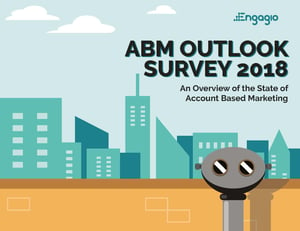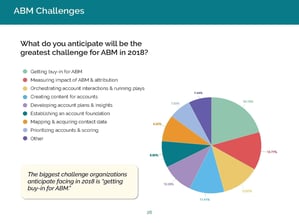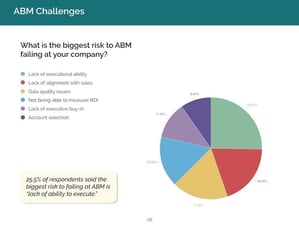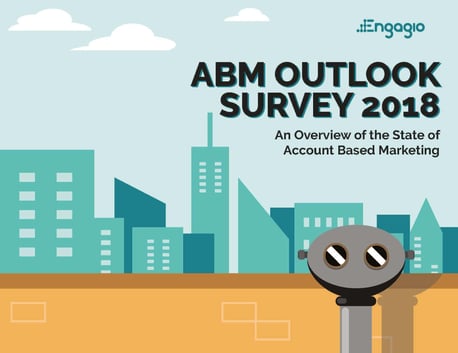Concerning News From Engagio's ABM Outlook Survey
 Unless you're some modern day Rip Van Winkle, you're well aware of the account-based marketing (ABM) buzz of the last couple years. ABM can be incredibly effective as a supplement to other demand and lead gen programs, particularly for companies with strong sales and marketing alignment and those with thoughtful account targeting and strategic account sales programs.
Unless you're some modern day Rip Van Winkle, you're well aware of the account-based marketing (ABM) buzz of the last couple years. ABM can be incredibly effective as a supplement to other demand and lead gen programs, particularly for companies with strong sales and marketing alignment and those with thoughtful account targeting and strategic account sales programs.
But, it's not a lay-up. In fact it's a lot of work, and effective execution requires thoughtful vision and cerebral execution.
Engagio's recently released "ABM Outlook Survey 2018: An Overview of the State of Account-Based Marketing" recaps the findings of their survey of 1,260 companies currently using ABM.
The report uncovered some challenges and risks that can impede or cripple ABM programs.
 Among these were (click the images for larger versions):
Among these were (click the images for larger versions):
- 18% fear that data quality issues are the biggest risk to their program
- 21% believe their biggest challenge will be getting buy-in for the program - one of the biggest barriers to buy-in is missing KPIs to clearly justify the programs.
- 12.8% worry about measuring the impact and attribution
- 12.6% worry about orchestrating interactions and running plays
- 10.2% are unsure about developing account plans and insights
- 8.9% worry about mapping and acquiring contact data
 In sum, 65% of respondents see challenges related to lack/quality of data.
In sum, 65% of respondents see challenges related to lack/quality of data.
That's a stiff headwind for ABM, but it's not insurmountable.
Accounts versus Individuals
Who makes buying decisions? It's not accounts. On that we can certainly agree.
Our sales language pretends it is individuals, but there's ample evidence that it's rapidly growing buying teams which decide by consensus. Those teams are small collections of individuals.
So if you're selling a complex manufacturing solution to a buying team from a large CPG company, for instance, there will likely be buying team members representing plant engineering, corporate engineering, controls, IT, safety, HR, plant maintenance, corporate finance and plant management. It's often not tied closely to seniority or title.
With a workforce of tens of thousands, the fact that a few people from the company may have seen/engaged with your messaging is of almost no consequence in moving a buying team further along — regardless of where they are in the buying journey.
You have to influence, engage and connect with the handful of people involved. That requires segmented and personalized marketing and sales approaches. Yet personalized marketing and effective sales are predicated on knowing who is/could actively participate in a purchase.
In sophisticated and patient execution of large-account ABM focused on the C-suite, this is managed by researching the org chart and targeting those who you want to sell to — and sticking with it for a couple years with completely individualized content and campaigns.
In most applications of ABM, however, that means correlating engagement activities with actual people at multiple levels in the organization.
And that's the Achilles heel of ABM as it's practiced at-scale by most companies.
There's a solution.
Buyer Intent Data Could/Should Connect the Contact Dots for ABM
Some will argue that all that's needed is just to cast a wider net (even though ABM is predicated on spear fishing in contrast to a wider net!) to enroll more contacts from a company in ABM workflows. If that's true, then simply downloading larger lists from RainKing (DiscoverOrg) would do the trick.
It doesn't, of course, because those are just random individuals. And random individuals, whether pulled from static lists or presumed based on anonymous activity, are just that: random. And so while buyer intent data is often proposed as a fix for this shortcoming in ABM, it typically perpetuates the challenge with "contacts" that are derived from anonymous IP-based activity observations and "overlaid" contact details pulled from another source.
Most buyer intent data fails to deliver this. An honest description of the lead would sound something like "someone at XYZ company facility looked at your competitor's website, and since we know you'd like to talk to the VP of Engineering, here are his/her contact details that we happened to find, completely unrelated, in LinkedIn Sales Navigator."
However, when Buyer Intent Data delivers actual contact details, it provides an effective compliment to ABM that addresses nearly all of the data risks and challenges captured in Engagio's data.
That's what Sales Fracking™ Buyer Intent Data does.
The description of a Sales Fracking lead sounds like, "You said you wanted to know when a VP of Engineering from a firm in XYZ industry with this many employees, located in this geography, took action around this key term (or competitor, or influencer, or event) - Jane Smith meets those criteria, and just took action on LMN competitor's site. Here are her company, title, email address, main phone, Twitter handle and LinkedIn profile."
That's actionable information!
Real Buyer Intent Data Driving ABM
Actual contact actions and buying trigger context (what someone did and where) are the allure of buyer intent data, and the power is realized with the addition of actual contact details. But how do you use that effectively to improve ABM outcomes?
Like much in digital marketing, it's simple but not easy.
Sales Fracking buyer intent data provides the key details to inform the process.
- Title - you can gauge their role in the decision by department and seniority
- Trigger - what they've taken action on (what competitor, key term, influencer, etc.)
- Source - where they've taken action (competitor's website, elsewhere on the web)
- Additional key contacts - others who the algorithm finds are likely involved in the discussion by virtue of their online behaviors which might not yet meet the threshold criteria of the algorithm, but indicate they're somehow participating
With that information you can segment leads and enroll them in nuanced ABM plays depending on what you infer from their role and actions. Of course that means that you'll need varied and nuanced plays, which will require that you understand the business outcomes and barriers from the perspective of each of the departments/roles involved.
Once you've done the segmentation, and created the plays, you'll be able to apply it at-scale.
You'll also have the opportunity to get very personal too. Since you'll know who the actual people are, you'll be able to include personal contact from the right strategic account manager, including emails, phone calls, actual physical mail, event connections, social touches and more. Key contacts often provide sales intelligence to your team working through a deal champion with a buying team.
Virtual Spear Fishing...finally
The ABM Martech community has pushed the visualization of ABM as the spear fishing analogy to inbound marketing's net approach. That's an interesting way to see it, and DemandGen has reinforced that analogy.
But when ABM is pursuing nameless, faceless, anonymous employees of a target account, that's akin to blindfolded spear fishing. One doesn't have to ponder how that turns out.
If you want to spearfish responsibly (whether that means safely, or prudently with your company's ABM dollars) you have to see clearly where you're aiming.
ABM hasn't solved that in general yet, and that's why there are such profound concerns around data, measurement and buy in. Buyer intent data holds promise, but most fails to deliver. Sales Fracking Buyer Intent Data, however, largely resolves this issue and provides the key to successful ABM at scale.
One Other Thought
Really well executed ABM also requires sensible target account selection. It's remarkable how few companies have a framework for doing this in a consistent way that maps to company strategy. Often sales reps are asked to submit a list of goal accounts and that's it. Maybe there's a national accounts group that is targeted based on opportunity size. Rarely, however, do small and middle market industrials map market trends into the future and work that, and other strategic factors, into a formal, consistent framework for identifying and prioritizing target accounts.
That's a huge missed opportunity that illustrates the role of corporate strategy in sales and marketing, and in the importance of sales and marketing alignment.





